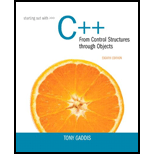
Concept explainers
Inventor Class
Design an Inventory class that can hold information and calculate data for items in a retail store’s inventory. The class should have the following private member variables:
| Variable Name | Description |
| itemNumber | An int that holds the item’s item number. |
| quantity | An int for holding the quantity of the items on hand. |
| cost | A doubl e for holding the wholesale per-unit cost of the item |
| totalCost | A double for holding the total inventory cost of the item (calculated as quantity times cost). |
The class should have the following public member functions:
| Member Function | Description |
| Default Constructor | Sets all the member variables to 0. |
| Constructor #2 | Accepts an item’s number, cost, and quantity as arguments. The function should copy these values to the appropriate member variables and then call the setTotalCost function. |
| setltemNumber | Accepts an integer argument that is copied to the itemNumber member variable. |
| setQuantity | Accepts an integer argument that is copied to the quantity member variable. |
| setCost | Accepts a double argument that is copied to the cost member variable. |
| setTotalCost | Calculates the total inventory cost for the item (quantity times cost) and stores the result in total Cost. |
| getltemNumber | Returns the value in itemNumber. |
| getQuanti ty | Returns the value in quantity. |
| getCost | Returns the value in cost. |
| getTotalCost | Returns the value in total Cost. |
Demonstrate the class in a driver program.
Input Validation: Do not accept negative values for item number, quantity, or cost.
Want to see the full answer?
Check out a sample textbook solution
Chapter 13 Solutions
Starting Out with C++ from Control Structures to Objects (8th Edition)
Additional Engineering Textbook Solutions
Starting Out with Java: From Control Structures through Data Structures (4th Edition) (What's New in Computer Science)
Computer Science: An Overview (13th Edition) (What's New in Computer Science)
Problem Solving with C++ (10th Edition)
Electric Circuits. (11th Edition)
INTERNATIONAL EDITION---Engineering Mechanics: Statics, 14th edition (SI unit)
Introduction To Programming Using Visual Basic (11th Edition)
- Please solve and answer the questions correctly please. Thank you!!arrow_forwardConsidering the TM example of binary sum ( see attached)do the step-by-step of execution for the binary numbers 1101 and 11. Feel free to use the Formal Language Editor Tool to execute it; Write it down the current state of the tape (including the head position) and indicate the current state of the TM at each step.arrow_forwardI need help on inculding additonal code where I can can do the opposite code of MatLab, where the function of t that I enter becomes the result of F(t), in other words, turning the time-domain f(t) into the frequency-domain function F(s):arrow_forward
 Microsoft Visual C#Computer ScienceISBN:9781337102100Author:Joyce, Farrell.Publisher:Cengage Learning,
Microsoft Visual C#Computer ScienceISBN:9781337102100Author:Joyce, Farrell.Publisher:Cengage Learning, EBK JAVA PROGRAMMINGComputer ScienceISBN:9781337671385Author:FARRELLPublisher:CENGAGE LEARNING - CONSIGNMENT
EBK JAVA PROGRAMMINGComputer ScienceISBN:9781337671385Author:FARRELLPublisher:CENGAGE LEARNING - CONSIGNMENT Systems ArchitectureComputer ScienceISBN:9781305080195Author:Stephen D. BurdPublisher:Cengage Learning
Systems ArchitectureComputer ScienceISBN:9781305080195Author:Stephen D. BurdPublisher:Cengage Learning C++ for Engineers and ScientistsComputer ScienceISBN:9781133187844Author:Bronson, Gary J.Publisher:Course Technology Ptr
C++ for Engineers and ScientistsComputer ScienceISBN:9781133187844Author:Bronson, Gary J.Publisher:Course Technology Ptr EBK JAVA PROGRAMMINGComputer ScienceISBN:9781305480537Author:FARRELLPublisher:CENGAGE LEARNING - CONSIGNMENTProgramming Logic & Design ComprehensiveComputer ScienceISBN:9781337669405Author:FARRELLPublisher:Cengage
EBK JAVA PROGRAMMINGComputer ScienceISBN:9781305480537Author:FARRELLPublisher:CENGAGE LEARNING - CONSIGNMENTProgramming Logic & Design ComprehensiveComputer ScienceISBN:9781337669405Author:FARRELLPublisher:Cengage





